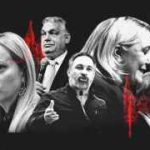The claim of superiority of ethnic Russians over newcomers and, more generally, non-Russians, is manifested today in new, very aggressive forms of association under the generic title of Russkaja Obščina (Russian Community). By weakening the state authority itself, they border on uncontrollable extremism as in the times of anti-Semitic pogroms, today directed mainly against Muslims.
Moscow () – In addition to the official ideology of the “Russian world”, turned against globalism in the name of “multipolarity”, an internal nationalism is growing in Russia, more typical of many societies put in crisis by migratory flows, with the vindication of the superiority of ethnic Russians over newcomers and, more generally, over non-Russians, a recurring phenomenon in a country that has always sought the fusion of different nationalities. This is now manifesting itself in new, very aggressive forms of association, under the generic title of Russkaja Obščina, “Russian Community.” Ethnologist Kharun Sidorov has attempted to explain the reasons for this phenomenon in Idel.Realii, noting that “nationalist impulses are cyclical in Russian history.
“The feelings of Russians are greatly influenced by the positions of the ruling power, more than in other countries, precisely by the traditional colonial policy that seeks to encompass numerous ethnic groups.” Another expert, Miroslav Grokh, distinguishes two types of nations, which generate different inspirations: “state” ones and those corresponding to non-state national movements. Anti-Russian nationalisms aimed at “decolonization” are surpassed by the “state nationalism” of the Russians, and in this context it is clear that Russian nationalism is recognized in the leader in power, as today in Vladimir Putin, and not It is an opposition movement, although it is difficult to control even from the Kremlin.
As Kharun recalls, in the past there were Russian nationalist movements of radical opposition to tsarism, especially at the beginning of the 20th century, which appealed to “civil nationalism” of a European nature, from Herzen to Bakunin through the so-called narodniki (the “popular” ), as well as liberal-nationalists such as Petr Struve, also in opposition to the Soviet revolution. The most authentic face of Russian nationalism, however, has always been that of the so-called černosotentsy, the “red-browns”, also evoked in the “fascio-communist” inspiration of the 1990s. The latter have also often been inspired by religious symbology, such as the “Union of Michael the Archangel”, the “Holy Vigilance” and others, with an aggressive spirit towards the Jews, the Freemasons, the minor and hostile peoples such as the known Poles. like ljakhy, or even the ukrainians known as khokhly, always in veneration of the “tsar-father” of the homeland.
Even today, variants of the “Russian community” claim to represent the State, using various forms of pressure and violence against foreigners, and with this they actually make the State’s own authority more fragile, crossing borders towards uncontrollable extremism such as in the times of anti-Semitic pogroms in Tsarist Russia, today directed mainly against Muslims. Parliamentary and legislative initiatives for the exaltation of the “constituent people of the State”, an expression that also applies to the Orthodox Church, in fact reintroduce a division between first and second degree citizens, in increasingly sharp and divisive forms, as observed Kharun.
This risks losing the hard-won support of Russian-speaking ethnic communities, among the many scattered throughout the Federation lands, and of religions other than Orthodox Christianity, in effect reviving anti-Russian nationalism even among groups very small in many regions. The černosotentsy paradoxically weaken the expressions of the Russkij mir, once again denigrating minor peoples and emigrants as basurmany, another ancient expression to define hostile foreigners in Russian territory, a mixture of “Asians” and “Muslims.” According to experts, this contradiction between “governmental and non-governmental” nationalism never lasts long in the history of Russia, but usually ends with convulsions that destroy the State or its opponents, to begin again the cycle of an always unfinished amalgamation.
Russian imperialism once again shows its fragility, Kharun concludes, and paradoxically one of the greatest dangers for Putin’s regime would end up being the breakdown of its own ideology that provokes these regurgitations of extreme nationalism: the Russian world destroys the Russian world, in its most extreme variants.












Add Comment